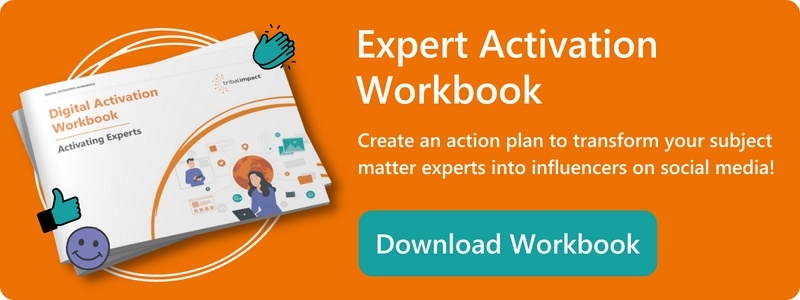According to Ogilvy, 89% of C-Suite marketers recognise the value of transforming employees into influencers (Source). However, many businesses are missing out on this huge untapped potential.
The reason? Influencer marketing has been firmly established in B2C for years but it’s fast becoming a part of the B2B marketing toolkit as buyer’s consumption habits and sources of research have changed:
- 75% of the workforce will be digital natives by 2025 (Source: Harvard Business Review).
- 90% of business decision-makers initiate their purchasing process by researching opinions from industry experts and peers (Source: Brandfit).
- Influencer marketing returns 11x the ROI of other promoted content.
- 92% of buyers trust recommendations and suggestions from friends and family more than advertising (Source: Nielsen).
B2B influencer marketing differs from B2C marketing, which has earned itself a reputation of ‘pay to promote’. In contrast, trust and credibility are the currency of B2B relationships. B2B Influencers can’t be bought (at least not long-term).
Instead, they’re seeking opportunities to learn something new and to co-create content that adds value or experiences to their audience.
Example: Maximus track the earned media value of their employee advocacy program which equated to $7,078 earlier this year. Read more.
Employee advocacy can have a significant part to play in your employee influencer program’s success. They go hand-in-hand and can build momentum much faster than when they operate in silo. Here’s how.
Influencers want to connect with your experts, not marketing
Marketing may be great at creating engaging and compelling content, but the most trusted source of content is that which is created and shared by your company’s subject matter experts. They have a deep-seated knowledge of what they do because they're living and breathing it daily. They've usually worked their way to that position and you can't gain their level of knowledge by reading a book.And with x10 the collective network size of your company network, the potential for reach is far greater. (Source: LinkedIn).
Authentic conversations can only happen when you connect external influencers to your internal subject matter experts (your employee influencers). The conversations are more natural, insightful, and valuable. Both parties learn something new and it sets a long-term beneficial relationship.
Employee advocacy helps scale your influencer strategy
Marketing is almost always the sole department that leads influencer marketing strategy but you can't build a successful influencer program alone.
Engaging with influencers involves building a relationship with them over time by sharing and commenting on their posts. Your comments should add to the conversation with unique insights; saying more than a ‘totally agree’ or ‘great post’.
Your content needs to appear on their radar too. One way to achieve this is by helping your internal subject matter experts shine as thought leaders and influencers, someone an industry or external influencer would want to collaborate with.
This takes a lot of time. It needs to be consistent and over the space of at least a few months. (One quick comment, a like, and a share won’t cut it!)
Employee advocacy can help you scale your efforts quickly. Employee-shared content is viewed as 8 times more authentic and 7 times more likely to generate positive action than company-shared content (Source: LinkedIn).
This means that their content is more likely to extend into your influencer’s network. And when trained effectively, they can quickly add insightful comments in a much more timely and credible way than marketing alone.
The key to building influence is understanding who is already influential in the market, and where appropriate, strengthening ties with those individuals via employee relationships.
The Influencer/Advocacy Loop:

Activating employee advocates helps you build another influencer relationship and potentially the most powerful of all – customer influencers.
Employee advocates strongly agree to feeling connected and enthusiastic about their employer after sharing on social, according to Altimeter. That positivity will spread to their relationships with customers and, by listening to and engaging with customers online, employee advocates nurture those relationships further.
By listening to what influencers are writing and talking about, employees can produce and share content that resonates with your customers. Then, once they begin to co-create with influencers, the content becomes even more relevant and engaging for your customers.
Employee advocates are also the best-placed to share experiences of how you live and breathe your values. We know that buyers prefer to do business with people that share the same values as them (and that includes repeat customers).
This powerful mix makes for loyal and happy customers, who then become your biggest advocates, sharing your content and referring business. What's more, a referred customer is about 25% more valuable compared to non-referred customers.
Your subject matter experts become external influencers
An effective employee advocacy program activates your willing employees on social media, helping move them through the 9 Stages of Employee Social Maturity via targeted training.

Enthusiasts (those who share daily but with little engagement) can become Thought Leaders. By following influencers, they learn what's relevant to their audience. They then learn how to add their point of view and begin to build relationships with influencers, building to a position where they become an established thought leader.
Thought Leaders can then become Influencers. By building on the relationships they’ve formed with influencers, they can begin to co-create content. As their joint exposure and credibility builds, they then start to become influential in their own right.
Mastering B2B influencer marketing
Influencer marketing and employee advocacy should never sit alone. As you can see, when you integrate your campaigns, you’ll build much more momentum towards your goals – leading to better, long-term relationships with your influencers, customers, and employees.
And if you can empower and activate your most trusted subject matter experts for business-wide goals, that momentum will be even stronger.
Editor's Note: This blog was originally published in 2023 and has been refreshed for 2024.

